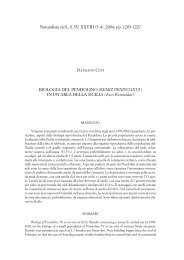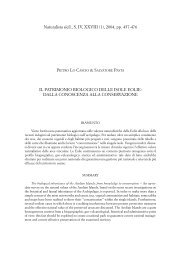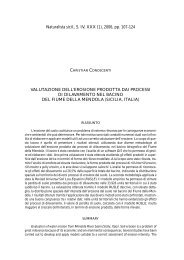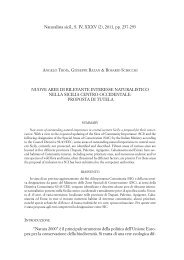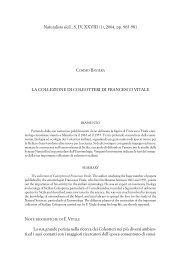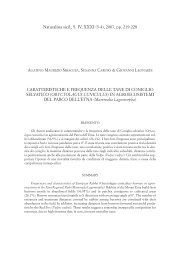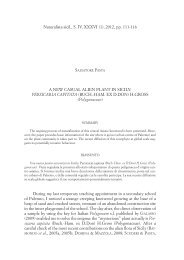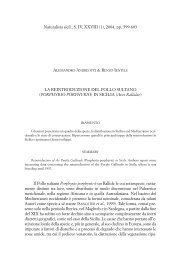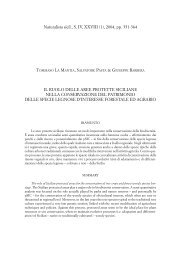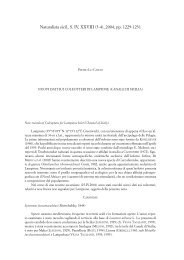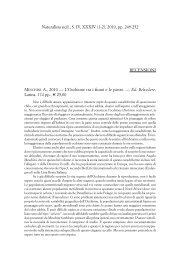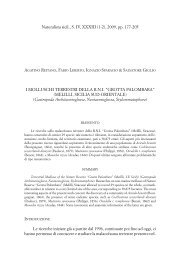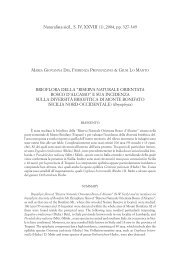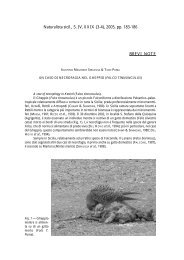2007,pp - Società Siciliana di Scienze Naturali
2007,pp - Società Siciliana di Scienze Naturali
2007,pp - Società Siciliana di Scienze Naturali
You also want an ePaper? Increase the reach of your titles
YUMPU automatically turns print PDFs into web optimized ePapers that Google loves.
262 M. SKUHRAVÁ, V. SKUHRAVY´ & B. MASSA<br />
bile accertare che la pianta ospite <strong>di</strong> Aplonyx chenopo<strong>di</strong>i De Stefani, 1908, è Atriplex patula (L.)<br />
(Chenopo<strong>di</strong>aceae), non Chenopo<strong>di</strong>um album L., come in<strong>di</strong>cato nella descrizione originale. La<br />
fauna <strong>di</strong> Cecidomi<strong>di</strong> è composta dal 48% <strong>di</strong> specie me<strong>di</strong>terranee, 25% europee, 13% eurosiberiane,<br />
7% cosmopolite, 3% afrotropicali, 2% euroasiatiche e 2% asiatiche. Procontarinia matteiana<br />
Kieffer et Cecconi, 1906, Contarinia citri Barnes, 1944, Dicro<strong>di</strong>plosis pseudococci (Felt,<br />
1914), Hori<strong>di</strong>plosis ficifolii Harris et Goffau, 2003 e Lesto<strong>di</strong>plosis aoni<strong>di</strong>ellae Harris, 1968 sono<br />
specie aliene in Sicilia. Pulmilomyia De Stefani, 1929 è un nuovo sinonimo <strong>di</strong> Pumilomyia De Stefani,<br />
1919 e Pulmilomyia artemisiae De Stefani, 1929 un nuovo sinonimo <strong>di</strong> Pumilomyia protrahenda<br />
De Stefani, 1919. Dasineura oleae (Angelini, 1831) è un nome valido, Cecidomyia oleae<br />
F. Löw, 1885 è un suo sinonimo (omonimo junior). Asphondylia ca<strong>pp</strong>aris Rübsaamen, 1893 è una<br />
specie siciliana, descritta su materiale trovato a Catania nell’ottobre 1893; essa, non Asphondylia<br />
genna<strong>di</strong>i (Marchal, 1904), è l’induttrice delle galle all’interno dei boccioli florali <strong>di</strong> Ca<strong>pp</strong>aris spinosa<br />
L. Viene infine presentata una check-list delle specie <strong>di</strong> Sicilia comprendente anche le specie<br />
botaniche ad esse associate.<br />
INTRODUCTION<br />
In 1994 a total of 324 species of the family Cecidomyiidae were known<br />
to occur in Italy (SKUHRAVÁ & SKUHRAVY´, 1994; SKUHRAVÁ, 1995); 207 of<br />
them have been recorded in the northern regions, 195 in the southern ones,<br />
48 in Sicily and only 12 in Sar<strong>di</strong>nia. In the last thirteen years various investigations<br />
have been carried out and Italian fauna has been enriched with new<br />
records. At the moment, Italian fauna of Cecidomyiidae includes 490 species<br />
(SKUHRAVÁ, in prep.). Galls of several interesting species were also <strong>di</strong>scovered<br />
in Sicily; in the present article we summarize all data of gall midges<br />
found in Sicily till now, inclu<strong>di</strong>ng new records and ad<strong>di</strong>tional records of<br />
species whose galls were decribed by previous authors, but inducing insects<br />
were unknown.<br />
The first gall midge was <strong>di</strong>scovered in Sicily in 1840 on the stem of<br />
Seseli sp. and later on it was named and described as Lasioptera umbelliferarum<br />
(Kieffer, 1909). Teodosio DE STEFANI PEREZ (1853-1935) (named also<br />
STEFANI by non Italian authors) contributed importantly to the knowledge<br />
of Sicilian gall midges. He started his scientific career in the Zoological Institute<br />
of Palermo University, studying plant galls and <strong>di</strong>scovering several interesting<br />
species of gall midges (Diptera Cecidomyiidae) and gall wasps<br />
(Hymenoptera Cynipidae). He described ten gall midge species and established<br />
two new gall midge genera (Ampelosucta and Pumilomyia); he also<br />
stu<strong>di</strong>ed plant galls of Somalia, Erithrea, Libya, publishing many papers on<br />
this subject (CALECA & MINEO, 1988). He was much esteemed by contemporaneous<br />
entomologists and KIEFFER (1898, 1913) established two genera<br />
naming them in the honour of T. De Stefani Perez, namely Stefaniella Kieffer,<br />
1898 and Stefaniola Kieffer, 1913.



